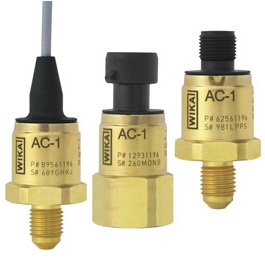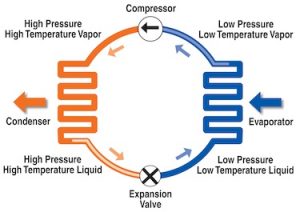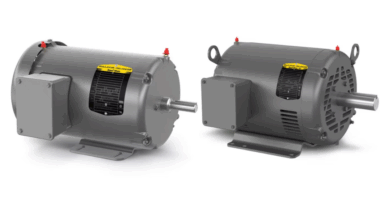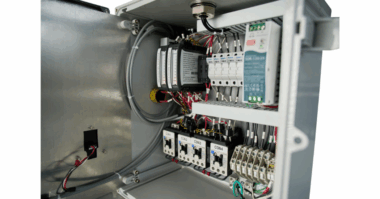One way to cut operating costs is to increase refrigeration and air conditioning efficiency. Ensuring that a cooling system is energy efficient can be as simple as seeking a high Seasonal Energy Efficiency Ratio (SEER) rating.
A cooling unit’s SEER rating is its cooling output in Btu during a typical cooling season, divided by the total electrical energy input in Watt-hours during the same period. A cooling unit’s SEER rating is directly proportional to its energy efficiency—higher is better.
Before the early 1990s, a SEER 8 cooling unit was thought to be highly efficient. As of January 2006, cooling units must have a minimum SEER of 13. For a unit to be qualified as ENERGY STAR, its minimum SEER must be 14. Today, some units exceed SEER 21.
As energy costs continue to escalate and governmental regulations continue to increase, refrigeration and HVAC manufacturers and OEMs must find ways to increase refrigeration efficiency and cooling system reliability.
Fortunately, changes in refrigeration unit control systems can greatly improve efficiency. Electronic thermal expansion valves (TXVs), temperature sensors, and pressure transmitters provide a simple solution to maximize refrigeration efficiency and meet current and future SEER regulations.
Refrigeration Basics
Whether a system is commercial or industrial refrigeration, air conditioning, freezers, or heat pumps, refrigeration basics are the same. Refrigeration units are closed-loop systems that use a vapor compression cycle to absorb and reject heat.
In its most basic form, a refrigeration system has five main components:
- Compressor
- Condenser
- Evaporator
- Expansion device
- Interconnecting piping.
The compressor compresses the refrigerant, which leaves the compressor as a high-temperature, high-pressure gas. The hot refrigerant enters the condenser, which removes heat from the refrigerant. The refrigerant leaves the condenser as a warm liquid.
From the condenser, the refrigerant travels to the expansion device, which meters the refrigerant into the evaporator. The sudden pressure drop on the evaporator side of the expansion device converts the refrigerant from a high-pressure warm liquid to a low pressure cold gas.
The cold gas absorbs heat from the air passing through the evaporator. The process of absorbing this heat converts the refrigerant into a cool dry gas. The cool dry gas refrigerant reenters the compressor, and the refrigeration cycle repeats.
Precise Superheat Control Increases Efficiency
Controlling refrigeration superheat and sub-cooling is the most effective means of optimizing refrigeration cycle efficiency. Superheat, which is measured at the evaporator outlet, is the difference between the actual temperature of the refrigerant and its boiling point at the measured pressure. Sub-cooling is the difference between the actual temperature of the refrigerant and its saturation temperature.
Controlling superheat and sub-cooling comes down to controlling when refrigerants boil and condense, which is very important in maintaining cooling unit efficiency while accommodating varying heat loads. Controlling these parameters correctly can provide near-perfect evaporator heat absorption across a wide range of thermal load conditions. If the refrigerant goes into the evaporator at the boiling temperature, and comes out at the boiling temperature, the system is as efficient as it will ever get.
Since superheat and sub-cooling control is so important to cooling unit efficiency, the expansion device, therefore, becomes a critical cooling system component. The expansion device regulates the amount of refrigerant that flows into the evaporator, which determines the superheating at the evaporator outlet.
Older cooling unit designs used a fixed-area restriction-type expansion device such as a plug orifice or a capillary tube. These devices perform moderately with constant evaporator loading and condenser pressures. However, since they are sized based on a single limited set of conditions, their ability to efficiently regulate refrigerant flow under changing heat load conditions is extremely limited.
Some older refrigeration units that used fixed orifice devices to meter the refrigerant had SEER values below 10—some with values as low as 6. Some of these units had superheat values as high as 25 degrees F, which means that the temperature of the refrigerant leaving the evaporator is 25 degrees F higher than its boiling point. This indicates very inefficient heat extraction.
Modern Control Methods
Modern electronic TXVs control the flow of refrigerant through the evaporator. The job of the electronic TXV is to ensure that it takes exactly as much refrigerant to absorb exactly as much heat as required to make the refrigerant turn into vapor as it leaves the evaporator—and no more.
The inputs to electronic TXVs are temperature sensors and pressure sensors.Electronic TXVs include a pressure sensor, temperature sensor, controller, and software or logic to oversee its operation. The pressure and temperature sensors are located at the evaporator outlet. The mechanical part of the valve is located at the evaporator inlet. The electronic control sends signals that cause the valve to actuate.
High quality pressure sensors such as those from WIKA are critical to cooling unit efficiency because the boiling point of refrigerant in a closed-system is controlled by changing the vapor pressure above it. The heating load is determined by knowing the phase of the refrigerant as it leaves the evaporator. Temperature above the boiling point indicates that the refrigerant evaporated too early. The electronic control senses this and responds by opening the expansion valve to supply more refrigerant.
Conclusion
We’ve come a long way since the SEER 6 days. The latest electronic TXVs proactively monitor cooling unit superheat and sub-cooling cycles, resulting in extremely low superheat values and SEER values as high as 23.
Refrigeration systems must become more efficient to comply with higher SEER value requirements. Accurately controlling cooling unit superheat increases system efficiency, lowers utility costs, and prolongs equipment life. Electronic TXVs with sensors such as the WIKA R-1 and AC-1 are the best solution today—and moving forward.
For over 60 years, WIKA Instrument Corporation has continuously advanced pressure gauge, pressure transmitter and temperature measurement instrumentation. As the global leader in lean manufacturing, WIKA offers a broad selection of stock and custom instrumentation solutions, which are often available for distribution within days. Producing over 43 million pressure gauges, diaphragm seals, pressure transmitters and thermometers worldwide annually, WIKA’s extensive product line provides measurement solutions for any application.





